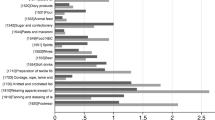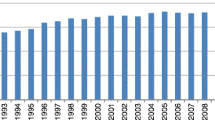Abstract
Past literature has established the relationship between productivity and exporting. This paper provides further understanding about this issue by examining the productivity effects of export status at different points of the conditional output distribution and by investigating the productivity effects of firms with different exporting status (i.e., new exporters versus continuous exporters). Plant-level data of Turkish manufacturing firms are analyzed using quantile regression techniques. The empirical results indicate that the productivity effect of exporting is present at all points along the conditional output distribution, and this effect increases as one moves from the lower tail to the upper tail of the distribution. Exporting firms that continuously exported throughout the time period have more pronounced productivity effects compared to firms in other categories (i.e., new exporting firms, exporting firms that exit, and exporting firms that switch exporting practices). These results have implications for firm behavior and for targeting policy prescriptions to augment manufacturing competitiveness.
Similar content being viewed by others
References
Arrow, K. (1962). The Economic Implications of Learning by Doing. Review of Economic Studies 29 (80): 155–173.
Aw, B., S. Chung, and M. Roberts (1998). Productivity and the Decision to Export Market: Micro Evidence from Taiwan and South Korea. NBER Working Paper 6558. National Bureau of Ecconomic Research, Cambridge, Mass.
Barro, R. J., and X. Sala-I-Martin (1995). Economic Growth. New York: McGraw-Hill.
Bassett, G., and R. Koenker (1982). An Empirical Quantile Function for Linear Models with iid Errors. Journal of the American Statistical Association 77 (378): 407–415.
Bernard, A. B., and J. B. Jensen (1995). Exporters, Jobs and Wages in U.S. Manufacturing, 1976–1987. Brooking Papers on Economic Activity (Microeconomics): 67–112.
Bernard, A. B., and J. B. Jensen (1998a). Understanding the U.S. Export Boom. NBER Working Paper 6438. National Bureau of Economic Research, Cambridge, Mass.
Bernard, A. B., and J. B. Jensen (1998b). Why Some Firms Export: Experience, Entry Costs, Spillovers, and Subsidies. Mimeo. Yale University.
Bernard, A. B., and J. B. Jensen (1999a). Exceptional Exporter Performance: Cause, Effect, or Both? Journal of International Economics 47 (1): 1–26.
Bernard, A. B., and J. B. Jensen (1999b). Exporting and Productivity. NBER Working Paper 7135. National Bureau of Economic Research, Cambridge, Mass.
Bernard, A. B., and J. Wagner (1997). Exports and Success in German Manufacturing. Weltwirtschaftliches Archive/Review of World Economics 133 (1): 134–157.
Bigsten, A., P. Collier, S. Dercon, M. Fafchamps, B. Gauthier, J. W. Gunning, J. Habarurema, A. Oduro, R. Oostendorp, C. Pattillo, M. Soderbom, F. Teal, and A. Zeufack, (2002). Do African Manufacturing Firms Learn from Exporting? Centre for the Study of African Economies Working Paper Series, WPS/2002-09, Oxford University.
Buchinsky, M. (1998). Recent Advances in Quantile Regression Models: A Practical Guide for Empirical Research. Journal of Human Resources 33 (1): 88–126.
Castellani, D. (2001). Export Behavior and Productivity Growth: Evidence from Italian Manufacturing Firms. Mimeo. ISE-Università di Urbino.
Clerides, S., S. Lach, and J. Tybout (1998). Is Learning-by-Exporting Important? Micro Dynamic Evidence from Colombia, Mexico, and Morocco. Quarterly Journal of Economics 113(3): 903–947.
D’Agostino, R. B., A. Balanger, and R. B. D’Agostino Jr. (1990). A Suggestion for Using Powerful and Informative Tests of Normality. American Statistician 44 (4): 316–321.
Diewert, E., and D. Lawrence (1999). Progress in Measuring the Price and Quantity of Capital. Discussion Paper 99/17. Deptmant of Economics, University of British Columbia.
Dimelis, S., and H. Louri (2002). Foreign Ownership and Production Efficiency: A Quantile Regression Analysis. Oxford Economic Papers 54 (3): 449–469.
Ericson, R. E., and A. Pakes (1995). Markov-Perfect Industry Dynamics: A Framework for Empirical Work. Review of Economic Studies 62 (1): 53–82.
Girma, S., D. Greenaway, and R. Kneller (2003). Export Market Exit and Performance. Dynamics: A Causality Analysis of Matched Firms. Economics Letters 80 (2): 181–187.
Girma, S., D. Greenaway, and R. Kneller (2004). Does Eporting Inerease Productivity?: A Microeconometric Analysis of Matched Firms. Review of International Economics 12 (5): 855–866.
Grossman, G., and E. Helpman (1991). Innovation and Growth in the Global Economy. Cambridge, Mass.: MIT Press.
Harper, M., E. Berndt, and D. Wood (1989). Rates of Return and Capital Aggregation Using Alternative Rental Prices. In D. W. Jorgenson and R. Landau (eds.), Technology and Capital Formation. Cambridge, Mass.: MIT Press.
Hendricks, W., and R. Koenker (1991). Hierarchial Spline Models for Conditional Quantiles and the Demand for Electricity. Journal of American Statistical Association 87 (417): 58–68.
Hopenhayn, H. (1992). Entry, Exit, and Firm Dynamics in Long-Run Equilibrium. Econometrica 60 (5): 1127–1150.
Jarque, C. M., and A. K. Bera (1980). Efficient Tests for Normality, Heteroskedasticity, and Serial Independence of Regression Residuals. Economics Letters 6 (3): 255–259.
Jovanovic, B. (1982). Selection and the Evolution of Industry. Econometrica 50 (3): 649–670.
Jovanovic, B., and S. Lach (1991). The Diffusion of Technology and Inequality among Nations. NBER Working Paper 3732. National Bureau of Economic Research, Cambridge, Mass.
Koenker, R. (2004). Quantile Regression for Longitidinal Data. Working Paper. University of Illinois at Urbana Champaign.
Koenker, R., and G. Basett (1978). Regression Quantiles. Econometrics 46 (1): 33–50.
Koenker, R., and K. F. Hallock (2001). Quantile Regression. Journal of Economic Perspectives 15 (4): 143–156.
Kraay, A. (1999). Exports and Economic Performance: Evidence from a Panel of Chinese Enterprises. Mimeo. World Bank, Washington, D.C.
Krugman, P. (1979). A Model of Innovation, Technology Transfer, and the World Distribution of Income. Journal of Political Economy 87 (2): 253–266.
Lucas, R. E. (1988). On the Mechanics of Economic Development Planning. Journal of Monetary Economics 22 (1): 3–42.
Mata, J., and J. A. F. Machado (1996). Firm Start-Up Size: A Conditional Quantile Approach. European Economic Review 40 (6): 1305–1323.
Mukoyama, T. (2006). Rosenberg’s “Learning by Using” and Technology Diffusion. Journal of Economic Behavior & Organization 61 (1): 123–144.
Olley, G. S., and A. Pakes (1996). The Dynamics of Productivity in the Telecommunications Equipment Industry. Econometrica 64 (6): 1263–1297.
Parente, S., and E. Prescott (1994). Barriers to Technology Adaptation and Development. Journal of Political Economy 102 (2): 298–321.
Rivera-Batiz, L. A., and P. Romer (1991). Economic Integration and Endogenous Growth. Quarterly Journal of Economics 106 (1): 531–555.
Rosenberg, N. (1982). Inside the Black Box: Technology and Economics. Cambridge: Cambridge University Press.
Solow, R. (1957). Technical Change and the Aggregate Production Function. Review of Economics and Statistics 39 (3): 312–320.
Van Biesebroeck, J. (2003). Exporting Raises Productivity in Sub-Saharan African Manufacturing Plants. NBER Working Paper 10020. National Bureau of Economic Research, Cambridge, Mass.
Wagner, J. (2002). The Causal Effects of Exports on Firm Size and Labor Productivity: First Evidence from a Matching Approach. Economics Letters 77 (2): 287–292.
Yasar, M., and R. M. Rejesus (2005). Exporting Status and Firm Performance: Evidence from a Matched Sample. Economics Letters 88 (3): 397–402.
Author information
Authors and Affiliations
Additional information
JEL no.
L11, L60
About this article
Cite this article
Yasar, M., Nelson, C. & Rejesus, R. Productivity and Exporting Status of Manufacturing Firms: Evidence from Quantile Regressions. Rev. World Econ. 142, 675–694 (2006). https://doi.org/10.1007/s10290-006-0088-2
Issue Date:
DOI: https://doi.org/10.1007/s10290-006-0088-2




